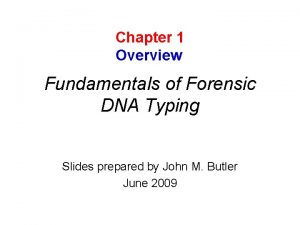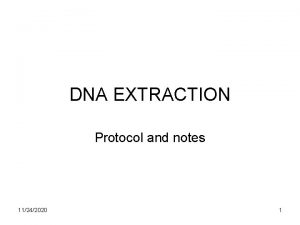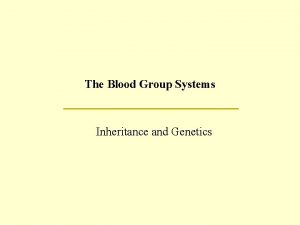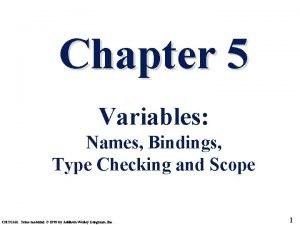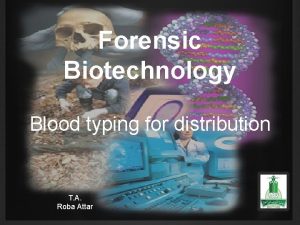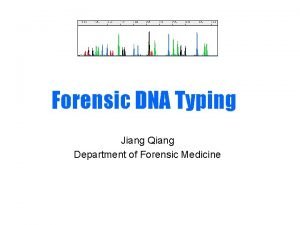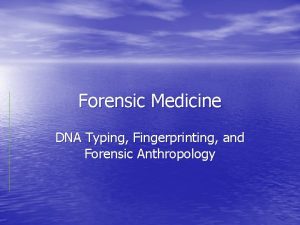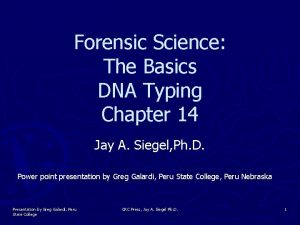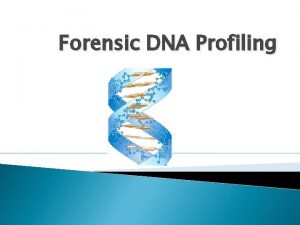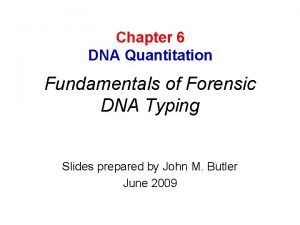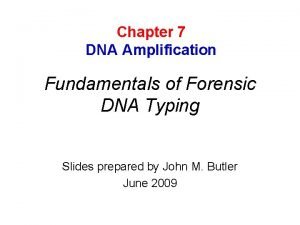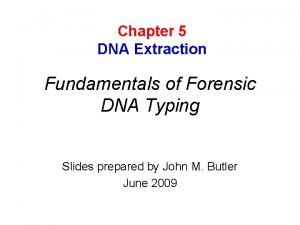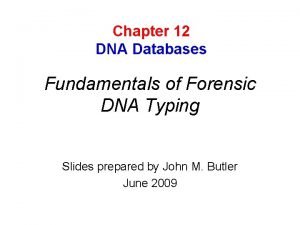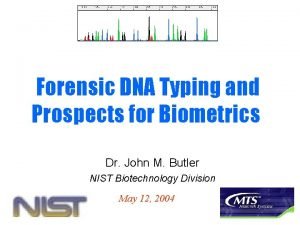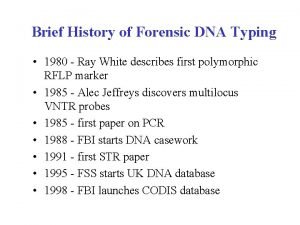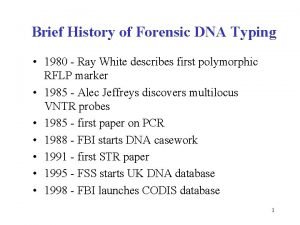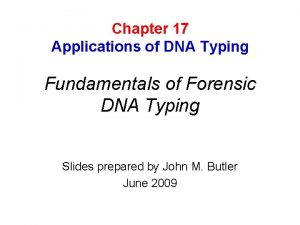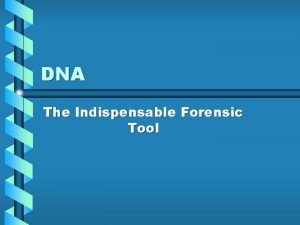Chapter 1 Overview Fundamentals of Forensic DNA Typing


























- Slides: 26

Chapter 1 Overview Fundamentals of Forensic DNA Typing Slides prepared by John M. Butler June 2009

Chapter 1 - Overview Chapter Summary Since its introduction in the mid-1980 s, forensic DNA testing techniques have enabled crime scene evidence to be matched to perpetrators with increasing sensitivity and speed. An example is used to illustrate how DNA analysis aided the investigation of a sexual assault committed in Charlottesville, Virginia in 1999. The role of forensic science and DNA testing are considered in the context of the criminal justice system. The steps in DNA sample processing are briefly reviewed and improvements to DNA testing are compared to advances in computer technology.

News Story on Montaret Davis DNA Database Match to University of Virginia Student Rape

Overview of the Criminal Justice System • The criminal justice system consists of three broad areas: – (1) law enforcement, (2) scientific analysis, and (3) legal proceedings • Detectives or investigators serving in police agencies submit evidence collected from crime scenes to forensic laboratories. This evidence is then compared to suspect reference samples (when available) or – in the case of DNA or fingerprints -- searched against a database of previous offenders as performed in the Virginia case just described. • A scientific report of the analysis of the evidence and comparison to the reference samples is then produced. This report is used by law enforcement and the legal community (prosecutors or defense attorneys) to make further decisions that may result in the evidence being presented in a court of law.

John M. Butler (2009) Fundamentals of Forensic DNA Typing, Figure 1. 1 Interactions between the Three Components of the Criminal Justice System Law Enforcement Police Agencies Scientific Analysis Legal Proceedings Forensic Laboratory Court System Validated scientific tests Legal framework and precedent (local, state, federal) Laws and police training Investigators/ Detectives Other Forensic Disciplines CSI DNA Unit DNA Analysts Evidence submitted Evidence returned Judge Prosecution Defense Scientific report(s) completed References submitted Research (introduces new methods) Trial Conviction or exoneration

Historical Perspective on DNA Typing 2009: DNA is an important part www. dna. gov of the criminal justice system President’s DNA Initiative (>$600 M from 2004 -2008) NDIS launched (October 13, 1998) Identifiler 5 -dye kit and ABI 3100 2002 UK National Database launched CODIS loci (April 10, 1995) defined Gill et al. (1985) Forensic application of DNA 'fingerprints‘. Nature 318: 577 -9 FSS 1994 1998 1990 1985 1992 PCR developed RFLP 1996 2006 mini. STRs 2004 Y-STRs Power. Plex® 16 2000 Quadruplex First STRs developed 2009 (16 loci in single amp) STR typing with CE is fairly routine First commercial fluorescent STR multiplexes mt. DNA Capillary electrophoresis of STRs first described DQA 1 & PM (dot blot) Multiplex STRs

Stages of Forensic DNA Progression Stages Time Frame Description Exploration 1985 -1995 Beginnings, different methods tried (RFLP and early PCR) Stabilization 1995 -2005 Growth 2005 -2009 Standardization to STRs, selection of core loci, implementation of Quality Assurance Standards Rapid growth of DNA databases, extended applications pursued Expanding tools available, confronting privacy concerns Sophistication The Future From John M. Butler (Feb 2009) Presentation at AAFS session on “Envisioning the Future”

John M. Butler (2009) Fundamentals of Forensic DNA Typing, D. N. A. Box 1. 2 Lessons from the First Case Involving DNA Testing Describes the first use of DNA (in 1986) to solve a double rape-homicide case in England; about 5, 000 men asked to give blood or saliva to compare to crime stains • Connection of two crimes (1983 and 1986) • Use of DNA database to screen for perpetrator (DNA only done on 10% with same blood type as perpetrator) • Exoneration of an innocent suspect • DNA was an investigative tool – did not solve the case by itself (confession of accomplice) A local baker, Colin Pitchfork, was arrested and his DNA profile matched with the semen from both murders. In 1988 he was sentenced to life for the two murders.

John M. Butler (2009) Fundamentals of Forensic DNA Typing, D. N. A. Box 1. 1 The Innocence Project http: //www. innocenceproject. org • Defense attorneys Barry Scheck and Peter Neufeld launched the Innocence Project in 1992 at the Benjamin N. Cardozo School of Law in New York City. • The Innocence Project promotes cases where evidence is available for post-conviction DNA testing and can help demonstrate innocence. The fact that truly innocent people have been behind bars for a decade or more has promoted legislation in a number of states and also at the federal level to fund post-conviction DNA testing.

Basis of DNA Profiling The genome of each individual is unique (with the exception of identical twins) and is inherited from parents Probe subsets of genetic variation in order to differentiate between individuals (statistical probabilities of a random match are used) DNA typing must be performed efficiently and reproducibly (information must hold up in court) Current standard DNA tests DO NOT look at genes – little/no information about race, predisposal to disease, or phenotypical information (eye color, height, hair color) is obtained

Human Identity Testing • Forensic cases -- matching suspect with evidence • • • Paternity testing -- identifying father Mass disasters -- putting pieces back together Historical investigations Missing persons investigations Military DNA “dog tag” Convicted felon DNA databases Involves generation of DNA profiles usually with the same core STR (short tandem repeat) markers

Steps in DNA Sample Processing John M. Butler (2009) Fundamentals of Forensic DNA Typing, Figure 1. 2 Sample Obtained from Crime Scene or Paternity Investigation DNA Extraction Biology PCR Amplification of Multiple STR markers DNA Quantitation Technology Separation and Detection of PCR Products (STR Alleles) Sample Genotype Determination Genetics Comparison of Sample Genotype to Other Sample Results Generation of Case Report with Probability of Random Match If match occurs, comparison of DNA profile to population databases

Suspect developed Crime committed Biological material transferred May match another Evidence (Question) sample “Q” Database Search Steps Involved Serology Collection Sample Storage Characterization Biology Extraction Quantitation Amplification Genetics Technology STR Markers Separation/ Detection Data Interpretation Statistical Interpretation Profile put on database Reference (Known) sample “K” (K’) Q U A L I T Y A S S U R A N C E Exclusion (no match) Q≠K Q DNA Profile Comparison May be Inconclusive due to Forensic Issues Steps Involved May be Inconclusive Collection due to Sample Storage Lack of Available Reference K Q=K Inclusion (match) Extraction Quantitation Amplification STR Markers Separation/ Detection (degradation, mixtures, low levels) Report (with statistical weight) Plea Data Interpretation Court John M. Butler (2009) Fundamentals of Forensic DNA Typing, Figure 1. 3 Profile put on database Q U A L I T Y A S S U R A N C E

DNA Testing Requires a Reference Sample A DNA profile by itself is fairly useless because it has no context… DNA analysis for identity only works by comparison – you need a reference sample Crime Scene Evidence compared to Suspect(s) (Forensic Case) Child compared to Alleged Father (Paternity Case) Victim’s Remains compared to Biological Relative (Mass Disaster ID) Soldier’s Remains compared to Direct Reference Sample (Armed Forces ID)

The Three Possible Outcomes of Evidence Examination “Suspect” Known (K) Sample • Exclusion (no match) • Non-exclusion 13 11 12 – “Match” or “inclusion” 11 12 • Inconclusive result “Evidence” Question (Q) Sample No result (or a complex mixture)

Steps Involved Collection Steps in Forensic DNA Analysis Usually 1 -2 day process (a minimum of ~5 hours) Slot Blot Specimen Storage 0. 3 ng No DNA 0. 5 ng 0. 7 ng 1 ng Extraction Blood Stain Buccal swab STR Typing Interpretation of Results Database Storage & Searching Calculation of Match Probability Genetics If a match occurs, comparison of DNA profile to population allele frequencies to generate a case report with probability of a random match to an unrelated individual DNA Database Search Biology Multiplex PCR 1 ng DNA Extraction Quantitation Multiplex PCR Amplification DNA separation and sizing Technology Sample Collection & Storage Quantitation 1 ng STR Typing Male: 13, 14 -15, 16 -12, 13 -10, 13 -15, 16 Interpretation of Results

The Laboratory Report • The end result of a forensic examination is a laboratory report, which represents a brief summary of work conducted by a forensic examiner (i. e. , DNA analyst). • The work represented in a laboratory report is based on following standard operating procedures. Prior to release of a lab report, data and conclusions are vetted through an internal review process culminating with a second reviewer and/or the DNA technical leader approving the work. • A lab report is typically submitted to police investigators to describe DNA typing results obtained from evidence and reference samples submitted. Depending on the results, this report may also be used by a prosecuting attorney during court proceedings to illustrate that a defendant matches (or cannot be eliminated as a possible contributor to) DNA evidence from a crime scene.

John M. Butler (2009) Fundamentals of Forensic DNA Typing, D. N. A. Box 1. 3 Example Laboratory Report from a DNA Examination ABC Laboratory Hometown, U. S. A. Report of Examination Date: December 8, 2008 Examiner Name: Sherlock Holmes Unit: Forensic Biology Case File Number: 08 -3101 -042 The specimens listed below were received in the Forensic Biology unit under cover of communication dated April 1, 2008 (080412001) and April 15, 2008 (080412312): Q 1 Q 2 K 1 K 2 Swab from broken, bloodstained glass in window frame (Item #2) Swab from keyboard of laptop computer (Item #7) Blood sample from SUSPECT 1 Buccal swab from SUSPECT 2 This report contains the results of the serological and nuclear DNA analyses.

John M. Butler (2009) Fundamentals of Forensic DNA Typing, D. N. A. Box 1. 3 Example Laboratory Report from a DNA Examination Results of Examinations: Blood was identified on specimen Q 1. Specimen Q 2 was examined for the presence of blood; however, no evidence of blood was found. Deoxyribonucleic acid (DNA) was isolated from specimens Q 1, Q 2, K 1 (SUSPECT 1), and K 2 (SUSPECT 2) and subjected to DNA typing by the polymerase chain reaction (PCR) at the amelogenin sex typing locus and fifteen (15) short tandem repeat (STR) loci of the Amp. Fl. STR Identifiler PCR Amplification Kit. The DNA typing results are detailed below: Specimen D 8 D 21 D 7 CSF D 3 TH 01 D 13 D 16 D 2 D 19 VWA TPOX D 18 AMEL D 5 FGA Q 1 12, 14 28, 30 9, 9 10, 10 16, 17 6, 6 11, 14 9, 11 22, 23 12, 14 17, 18 8, 8 14, 16 X, Y 12, 13 21, 22 Q 2 12, 14 28, 30 9, 9 10, 10 16, 17 6, 6 11, 14 9, 11 22, 23 12, 14 17, 18 8, 8 14, 16 X, Y 12, 13 21, 22 K 1 12, 14 28, 30 9, 9 10, 10 16, 17 6, 6 11, 14 9, 11 22, 23 12, 14 17, 18 8, 8 14, 16 X, Y 12, 13 21, 22 K 2 13, 14 30. 2, 32 8, 12 10, 12 17, 17 6, 9 8, 12 7, 8 23, 25 14, 14 17, 20 8, 10 14, 17 X, X 11, 13 21, 25 Based on the typing results from the amelogenin locus (for sex determination), male DNA is present in the DNA obtained from specimens Q 1, Q 2, and K 1 (SUSPECT 1). Based on the STR typing results and to a reasonable degree of scientific certainty, the contributor of specimen K 1 (SUSPECT 1) is the source of the DNA obtained from specimens Q 1 and Q 2. The probability of selecting an unrelated individual at random having an STR profile matching the DNA obtained from the questioned specimens is approximately 1 in 840 trillion from the Caucasian population, 1 in 16 quadrillion from the African American population, and 1 in 18 quadrillion from the Hispanic population. The STR typing results for specimen Q 1 will be entered into the Combined DNA Index System (CODIS) and maintained by the ABC Laboratory for future comparisons. No further serological or nuclear DNA examinations were conducted.

Applications for DNA Testing • • Crime solving – matching suspect with evidence… Accident victims – after airplane crashes… Soldiers in war – who is the “unknown” soldier… Paternity testing – who is the father… Immigration testing – are two people related… Missing persons investigations – whose remains… Convicted felons databases – cases solved… Involves generation of DNA profiles usually with the same core STR (short tandem repeat) markers and then MATCHING TO REFERENCE SAMPLE

Advantages for STR Markers • Small product sizes are generally compatible with degraded DNA and PCR enables recovery of information from small amounts of material • Numerous alleles per locus aid mixture interpretation • Multiplex amplification with fluorescence detection enables high power of discrimination in a single test • Commercially available in an easy to use kit format • Uniform set of core STR loci provide capability for national (and international) sharing of criminal DNA profiles

The Future of Forensic DNA Testing • Report published in Nov 2000 • Asked to estimate where DNA testing would be 2, 5, and 10 years into the future Conclusions STR typing is here to stay for a few years because of DNA databases that have grown to contain millions of profiles http: //www. ojp. usdoj. gov/nij/pubs-sum/183697. htm

Major Historical Events in Forensic DNA John M. Butler (2009) Fundamentals of Forensic DNA Typing, Table 1. 1 Compared to Timeline for Microsoft Corporation Year Forensic DNA Science & Application Parallel Developments in Biotechnology Microsoft Corporation Chronology 1985 Alec Jeffreys develops multi-locus RFLP probes PCR process first described First version of Windows shipped 1986 DNA testing goes public with Cellmark and Lifecodes in United States automated DNA sequencing with 4 colors first described Microsoft goes public 1988 FBI begins DNA casework with single locus RFLP probes 1989 TWGDAM established; NY v. Castro case raises issues over quality assurance of laboratories DNA detection by gel silver-staining, slot blot, and reverse dot blots first described 1990 Population statistics used with RFLP methods are questioned; PCR methods start with DQA 1 Human Genome Project begins with goal to map all human genes 1991 fluorescent STR markers first described; Chelex extraction Windows 3. 0 released (quality problems); exceeds $1 billion in sales Windows 3. 1 released

Major Historical Events in Forensic DNA John M. Butler (2009) Fundamentals of Forensic DNA Typing, Table 1. 1 Compared to Timeline for Microsoft Corporation Year Forensic DNA Science & Application Parallel Developments in Biotechnology 1992 NRC I Report; FBI starts casework with PCR-DQA 1 capillary arrays first described 1993 first STR kit available; sex-typing (amelogenin) developed first STR results with CE 1994 Congress authorizes money for upgrading state forensic labs; “DNA wars” declared over; FBI starts casework with PCR-PM Hitachi FMBIO and Molecular Dynamics gel scanners; first DNA results on microchip CE 1995 O. J. Simpson saga makes public more aware of DNA; DNA Advisory Board setup; UK DNA Database established; FBI starts using D 1 S 80/amelogenin ABI 310 Genetic Analyzer and Taq. Gold DNA polymerase introduced 1996 NRC II Report; FBI starts mt. DNA testing; first multiplex STR kits become available STR results with MALDI-TOF and Gene. Chip mt. DNA results demonstrated 1997 13 core STR loci defined; Y-chromosome STRs described Microsoft Corporation Chronology Windows 95 released Internet Explorer begins overtaking Netscape

Major Historical Events in Forensic DNA John M. Butler (2009) Fundamentals of Forensic DNA Typing, Table 1. 1 Compared to Timeline for Microsoft Corporation Year Forensic DNA Science & Application Parallel Developments in Biotechnology Microsoft Corporation Chronology 1998 FBI launches national Combined DNA Index System; Thomas Jefferson and Bill Clinton implicated with DNA 2000 SNP hybridization chip described Windows 98 released; anti-trust trial with U. S. Justice Department begins 1999 Multiplex STR kits are validated in numerous labs; FBI stops testing DQA 1/PM/D 1 S 80 ABI 3700 96 -capillary array for highthroughput DNA analysis; chromosome 22 fully sequenced 2000 FBI and other labs stop running RFLP cases and convert to multiplex STRs; Power. Plex 16 kit enables first single amplification of CODIS STRs First copy of human genome completed Bill Gates steps down as Microsoft CEO; Windows 2000 released 2001 Identifiler STR kit released with 5 -dye chemistry; first Y-STR kit becomes available ABI 3100 Genetic Analyzer introduced Windows XP released 2002 FBI mt. DNA population database released; Y-STR 20 plex published 2003 U. S. DNA database (NDIS) exceeds 1 million convicted offender profiles; the U. K. National DNA Database passes the 2 million sample mark Windows XP Tablet PC Edition released Human Genome Project completed with the “final” sequence coinciding with 50 th anniversary of Watson. Crick DNA discovery Windows Server 2003 released; 64 -Bit Operating Systems expand capabilities of software

Chapter 1 – Points for Discussion • What role does a forensic laboratory play in the criminal justice system? • What are some ways that DNA testing has impacted forensic science and the criminal justice system? • Discuss some communication skills that might be beneficial for a forensic DNA scientist to have in interacting with law enforcement and the legal community
 Fundamentals of forensic dna typing
Fundamentals of forensic dna typing Forensic science fundamentals and investigations chapter 6
Forensic science fundamentals and investigations chapter 6 Thomas mocker and thomas stewart
Thomas mocker and thomas stewart Forensic psychiatry vs forensic psychology
Forensic psychiatry vs forensic psychology Dna purification overview
Dna purification overview Dna polymerase function in dna replication
Dna polymerase function in dna replication Bioflix activity dna replication dna replication diagram
Bioflix activity dna replication dna replication diagram Coding dna and non coding dna
Coding dna and non coding dna What are the enzymes involved in dna replication
What are the enzymes involved in dna replication Dna and genes chapter 11
Dna and genes chapter 11 Typing doc.com
Typing doc.com Typing turtor
Typing turtor C# seminar
C# seminar Blood group reaction
Blood group reaction Typing special characters
Typing special characters Animated cartoon
Animated cartoon Abo grouping
Abo grouping Intersteno typing
Intersteno typing A python function definition begins with
A python function definition begins with Darwin information typing architecture
Darwin information typing architecture Duck typing
Duck typing Effects of poor typing techniques
Effects of poor typing techniques Blood grouping tube method
Blood grouping tube method Typing test
Typing test Proper keyboarding techniques
Proper keyboarding techniques Forensic biotechnology
Forensic biotechnology Typing
Typing
